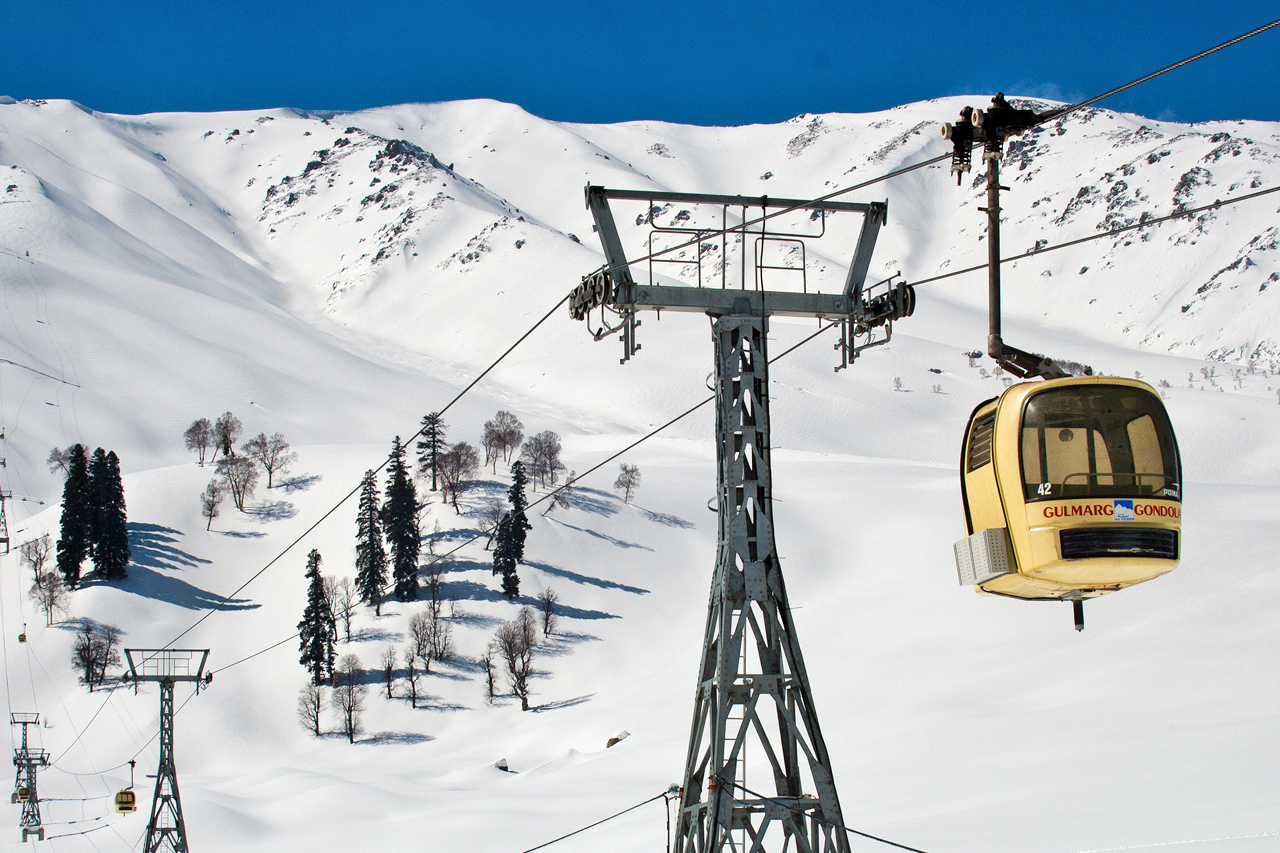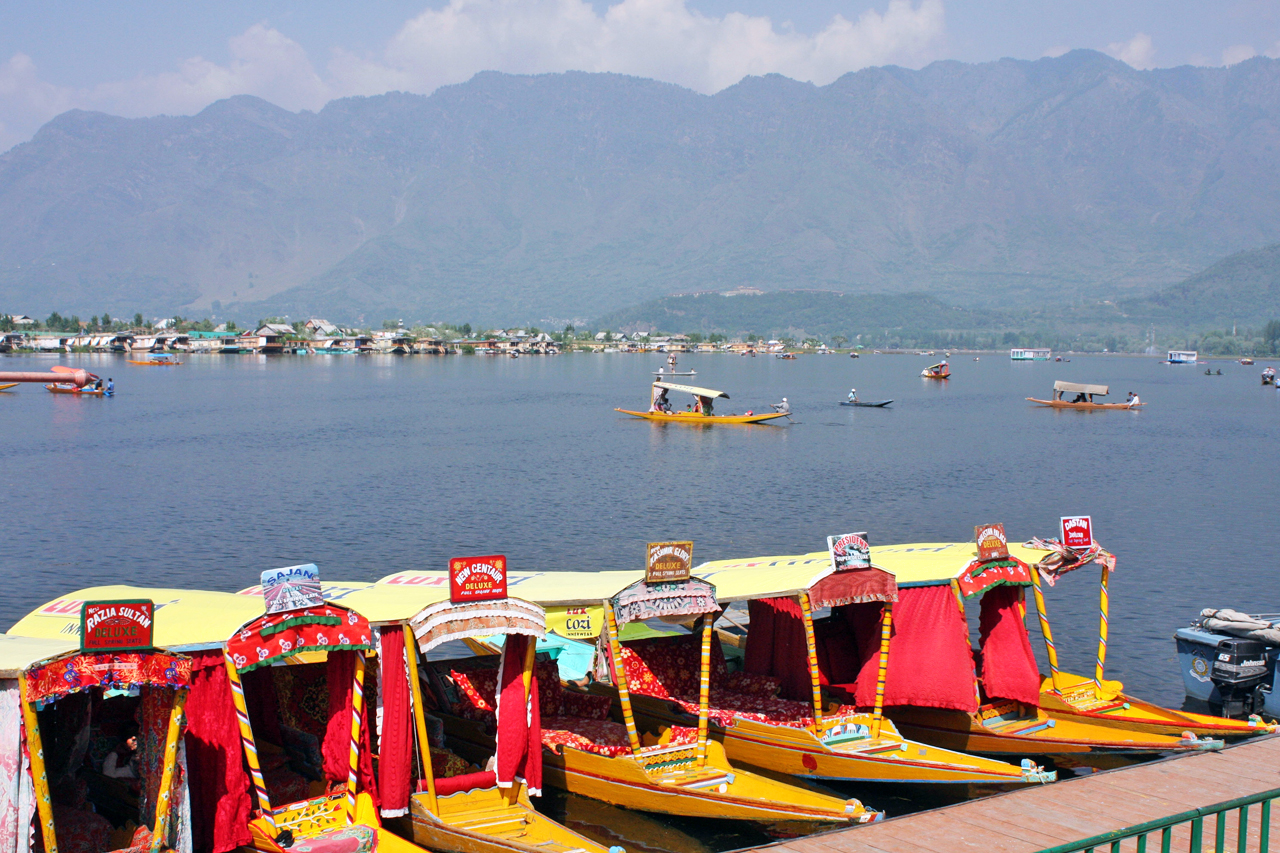Kashmir Paradise On Earth
"Gar Firdaus Bar mein Zameen Ast, Hamin Ast Hamin Ast"
"it means that if there is paradise on earth, this is it, this is it and this is it"

Places to Visit In Kashmir
GUlmarg
legendary beauty, prime location and proximity to Srinagar naturally make it one of the premier hill resorts in the country. Originally called ‘Gaurimarg’ by shepherds, its present name was given in the 16th century by Sultan Yusuf Shah, who was inspired by the sight of its grassy slopes emblazoned with wild flowers. Gulmarg was a favourite haunt of Emperor Jehangir who once collected 21 different varieties of flowers from here. Today Gulmarg is not merely a mountain resort of exceptional beauty- it also has the highest green golf course in the world, at an altitude of 2,650 m, and is the country's premier ski resort in the winter. The journey to Gulmarg is half the enchantment of reaching there-- roads bordered by rigid avenues of poplar give over to flat expanses of rice fields interspersed with picturesque villages. Depending on the season, nature's colours could be the translucent green of spring, summer’s rich emerald, or autumn’s golden hues, when scarlet chillies festoon windows of village homes. After Tangmarg, the climb to Gulmarg begins through fir-covered hillsides. At one point, known simply as View Point, travelers generally stop their vehicles for a few minutes and look out a spectacle of snow-covered mountains, almost within touching distance.
PAHALGAM - The Valley of Shepherds.
Situated at the confluence of the streams flowing from Sheshnag Lake and the Lidderriver, Pahalgam (2,130 m) was once a humble shepherd's village with breathtaking views. Now it is Kashmir's premier resort, cool even during the height of summer when the maximum temperature does not exceed 250C. A number of hotels and lodges cater to all preferences and budgets, from luxurious hotels to unpretentious trekkers' lodges, including J&K TDC's huts. Around Pahalgam are many places of interest, and because the resort is set between fairly steep hills, it is worth hiring a pony rather than walking. Pony fares are posted at prominent locations. The most beautiful of these is the huge, undulating meadow of Baisaran, surrounded by thickly wooded forests of pine. Hajan, on the way to Chandanwari, is an idyllic spot for a picnic. Filmgoers will recognize it instantly as it has been the location of several movie scenes
Sonamarg - The Meadow of Gold.
The drive to Sonamarg is through the Sindh Valley which presents yet another spectacular facet of countryside in Kashmir. Situated at an altitude of 2730 m, Sonamarg (‘The meadow of gold’) has, as its backdrop, snowy mountains against a cerulean sky. The Sindh River that meanders through the valley abounds with trout and mahaseer. Ponies can be hired for the trip up to Thajiwas glacier, which is a major local attraction during the summer months. Sonamarg is the base of a major trek that passes along several mountain lakes –Vishansar, Kishansar, Gadsar, Satsar and Gangabal. Sonamarg is also the take off station for the drive to Ladakh across the Zojila, a major pass in the Great Himalayan Range, through which the Srinagar-Leh Road passes. Sonamarg is also a base for undertaking the yatra to the holy Amarnath cave, during Sawan Purnima. For details about the yatra, refer to the Amaranathji Yatra Link.
Dal Lake In Kashmir
The Dal Lake is one of the most beautiful lakes, not only in Kashmir, rather in the whole of India. It is the second largest lake in Kashmir and is almost 6 km by 3 km in size. The main attractions of the lake are the encircling mountains, blossoming gardens and orchards, Shikaras and Houseboats. The embankments of Dal Lake also house a number of Mughal monuments and the campus of the University of Kashmir. Further beautifying the scenery of the lake are two hillocks that house the famous shrine of Shankaracharya and Hari Parbat temples. The other unique features of the Dal Lake are the famous Shikaras and Houseboats. Numerous houseboats line the lake, providing their guests with serene atmosphere and picturesque surroundings. The Shikaras provide ferry rides to and from the banks of the lake to the houseboats. The Dal lake of Kashmir, India is divided into four parts by causeways, namely Gagribal, Lokut Dal, Bod Dal and Nagin. Scenery of this lake also consists of clusters of sloping roofed houses on its islands. Apart from being one of the greatest attractions of the valley, Dal Lake also supports the second largest industry of the region, fishing. The plethora of fishes in the lake provides occupation to a large number of people in the valley. It is believed Dal Lake originated from the Pleistocene Oligotrophic Lake, which at one point of time covered the entire Kashmir valley.
Mughal Gardens In Kashmir
Impressed with abundant natural beauty, Mughals loved this place so much that they have contributed many beautiful gardens to the city of Srinagar. Well-planned and vast, these gardens are home to a variety of flora and delightful water systems. They retain something of the elaborately planned Persian gardens and are mostly terraced to suit the environs of the mountainous slopes.Shalimar Garden
beautiful Garden is built by Emperor Jehangir for his beloved wife Nur Jehan. It has four terraces and stretches across 539 by 182 meters, watered by the Harwan through canal lined with beautiful fountains. The fourth terrace is the best one and was once reserved for royal ladies and innumerable varieties of flowers bloom in spring and autumn.Chashmashahi
Chashmashahi the Royal Spring had been laid Shah Jehan in Srinagar in 1632. Renowned for the spring of refreshing digestive mineral water, this terraced garden has fountains in the middle and houses multiple kinds of fruits and flowers plants. The tall trees of Chinar can also be seen here. The picnic delights and long walks in the gardens, strolling hand in hand with your partner and treating all your five senses with the unforgettable pleasures are just a modest account of the place.Nishat Garden
Nishat Garden has been laid by The brother of Mughal Empress Nur Jehan, Asif Khan in Srinagar in 1633. Set on the banks of world famous Dal Lake, in the backdrop of Zabarwan hills, this terraced garden offers some magnificent views of the lake. The Garden has a beautiful water channel flowing right through its middle. Not a minute in the garden can be dull with its gorgeous Shikara rides up to the Nehru Park from here. The favorite picnic spot of the natives, a long walk amidst the lush greenery of this well-planned Garden refreshes oneself. There are also some shopping stalls opposite the garden.Harwan Garden
Harwan located in Srinagar, Harwan is a huge garden with a beautiful canal passing through its heart. Lined with flowerbeds and massive Chinar Trees, the canal is fed from a beautiful lake, which lies just behind the garden. Purposefully kept devoid of fanciful things and artificial fountains, the abundant natural beauty of the place complete with vast big green-carpeted lawns, makes it an ideal spot for picnics and excursions. Besides the delightful long walks in the Garden itself, it is also a take-off point for visiting Wild life sanctuary of Dachi Gam and a starting point of trekking up to Mahadev Mountain.Pari Mahal
Pari Mahal the erstwhile royal observatory, Pari Mahal boasts of a well planned and is just a five-minute drive from Cheshmashahi. The place also houses a Buddhist monastery of the olden times, converted later to a school of astrology by Dara Shikoh, the eldest son of Mughal Emperor Shah Jehan. This ancient monument retains a dream-like quality, illuminated at nights and placed on the very edge of a mountain casting its reflection in the waters of the Dal Lake with a well-laid spacious garden in front.



